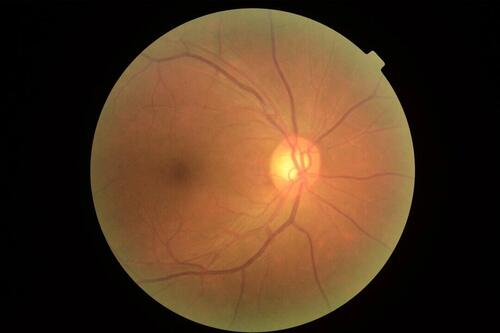Scientists Identify New Protein That Drives Age-Related Blindness, Uncover Potential Therapy
Authored by Cara Michelle Miller via The Epoch Times (emphasis ours),
Researchers have identified a protein that may prevent age-related macular degeneration (AMD), according to a new study published in the Developmental Cell on Oct. 2.
AMD is the leading cause of vision loss among older adults, affecting nearly 20 million Americans. As the population ages, this number is expected to rise significantly. Currently, there are no treatments that can stop AMD’s progression.

“I think we identified something that can target early-stage disease. … That’s a big deal,” the study’s lead author Ruchira Singh, an associate professor of ophthalmology at the University of Rochester in New York, told The Epoch Times.
The study used human stem cells rather than animal models, which may give a more accurate depiction of what is happening in AMD, according to the researchers.
“Older research methods have been limited in their ability to capture important aspects of either healthy or diseased human cells,” Singh noted.
Researchers Identify the Protein Driving AMD
The researchers extracted human stem cells from healthy people and AMD patients and programmed them into cells lining the retina.
Compared to healthy people, AMD patients’ retinal cells overproduced a type of protein called tissue inhibitor of metalloproteinase 3 (TIMP3), which leads to a buildup of fats and proteins called drusen. Drusen are a marker of early-stage AMD.
In AMD, the macula, the part of the retina responsible for sharp vision, becomes damaged.
In the early stages, yellow deposits of drusen begin to accumulate in the retina. Early AMD symptoms include blurred vision or seeing a black spot in the central field of vision, making everyday activities like reading, driving, and even recognizing faces increasingly difficult.
Dry AMD, which accounts for 90 percent of diagnosed cases, is characterized by the gradual buildup of drusen and slow vision loss. Wet AMD, which is less common and more severe, is linked to the growth of abnormal blood vessels under the retina.
In the study, researchers found that TIMP3 blocked another enzyme called matrix metallopeptidase 2 (MMP2), which acts as the eyes’ cleanup crew, removing harmful substances and keeping the eyes healthy. With less MMP2 activity, drusen accumulates, driving AMD disease.
Boosting MMP2 Prevents AMD
Singh’s team found that by blocking TIMP3, they could increase MMP2 levels, which help regulate inflammation and eye health. When MMP2 levels are low, inflammation increases, leading to more drusen buildup and vision loss.
By boosting MMP2 levels, the researchers were able to reduce drusen accumulation.
Singh’s team has filed provisional patents for enzyme inhibitors that could help treat the disease. Next steps include preclinical studies and determining the best method of delivery, such as oral medication or eye drops. Only after these stages conclude can the therapy be tested and, eventually, made available to patients.
Although the exact cause of AMD is not fully understood, genetic and environmental factors are known to contribute. Having a family history of AMD may increase the risk.
Specific genes, such as ABCA4, have been linked to the condition. However, research is ongoing to determine their role in treatment, according to a review published in Clinical Interventions in Aging.
Older age, smoking, obesity, and cardiovascular disease increase a person’s risk of AMD. Some studies have also linked diets high in saturated fat with an increased likelihood of AMD.
Lifestyle Preventative Tips
AMD progresses at different rates in different people. Up to 3 percent of people with minor drusen accumulation experience vision problems within five years, while about 50 percent with larger drusen develop late-stage AMD and vision loss within the same time frame.
Daily vitamins and nutritional supplements may help slow the progression of intermediate dry AMD.
According to the American Academy of Ophthalmology (AAO), certain nutrients benefit eye health, including vitamins C and E, zinc, lutein, zeaxanthin, and omega-3 fatty acids. These are linked to a lower risk of developing AMD later in life.
Citrus fruits, dark-green leafy vegetables, whole grains, fatty fish, and nuts are good food choices for supporting eye health.
Additionally, the AAO recommends a low-glycemic-index diet for those with AMD or who are at risk. Glycemic index indicates how quickly foods raise blood sugar, and low-glycemic-index diets tend to be high in nonstarchy vegetables and whole or minimally processed grains and low in processed foods.
Physical activity is also associated with lower odds of early and late AMD. The AAO notes that consistent physical activity, such as walking, cycling, swimming, and even active gardening, can help keep eyes healthy.
Without treatment, dry AMD can progress to wet AMD, which worsens quickly.
Tyler Durden
Fri, 10/04/2024 – 22:35

